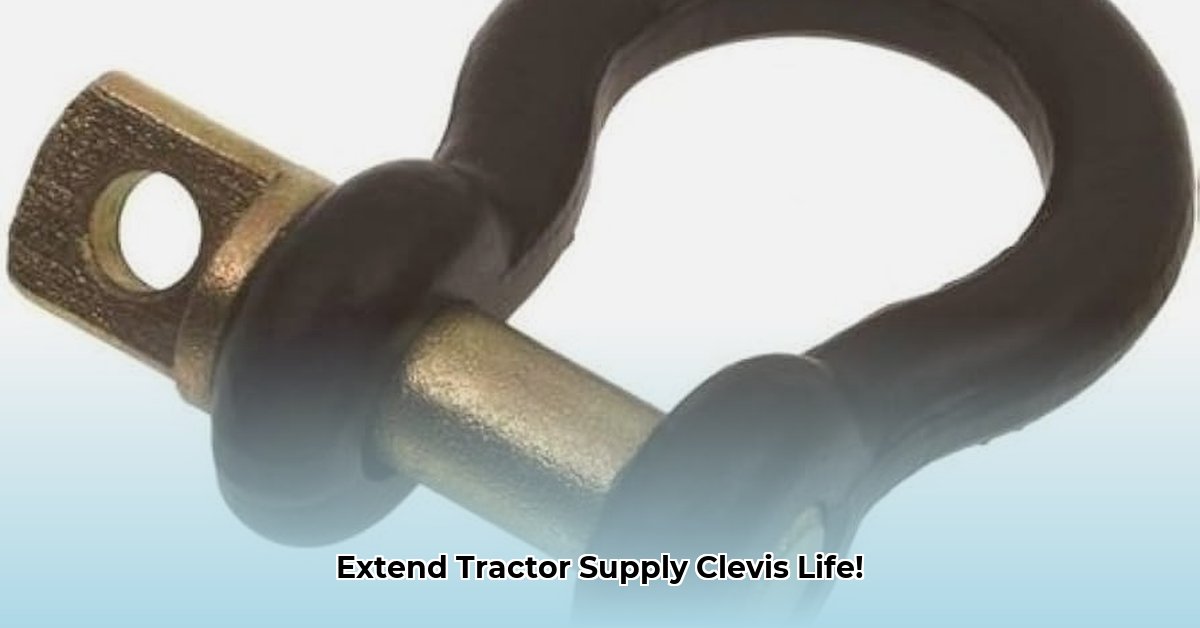
Choosing the right clevis pin might seem trivial, but this small component significantly impacts both your farm's efficiency and its environmental footprint. For more information on rock rake attachments, check out this helpful resource. This guide explores Tractor Supply's clevis pin offerings, showing how smart choices contribute to sustainable and economically sound farming practices. We'll cover selection, installation, maintenance, and even repair – demonstrating how extending the life of these seemingly insignificant parts can make a big difference.
Understanding Tractor Supply Clevis Pins
Tractor Supply offers various clevis pins, each suited to different tasks and stress levels. These aren't simply interchangeable; selecting the correct pin ensures safe and efficient equipment operation. Material is key: mild steel is sufficient for lighter tasks, while high-carbon steel provides superior strength and longevity for heavier-duty applications. Size is equally crucial; an improperly sized pin risks bending, breaking, or causing equipment damage.
Types of Clevis Pins at Tractor Supply
Here's a breakdown of common types:
| Clevis Pin Type | Material | Typical Uses | Expected Lifespan (Years) | Pros | Cons |
|---|---|---|---|---|---|
| Standard Clevis Pin | Mild Steel | General-purpose implement connections | 1-3 | Budget-friendly, readily available | Shorter lifespan, less robust in heavy-duty use |
| Heavy-Duty Clevis Pin | High-Carbon Steel | Heavy equipment, high-stress applications | 3-5+ | Exceptional strength, long-lasting | Higher initial cost |
| Cotter Pin Clevis Pin | Mild Steel w/Cotter Pin | Applications requiring extra safety and security | 2-4 | Added security against accidental detachment | Slightly more complex installation |
Don't overlook the importance of the cotter pin; it adds crucial security against accidental detachment, particularly in high-vibration or high-load applications. Isn't preventing equipment failure and potential injury a worthy investment?
Selecting the Right Clevis Pin: A Practical Guide
Choosing the correct clevis pin is paramount for equipment longevity and safety. Follow these steps:
Assess the Load: Determine the maximum load your equipment will exert on the pin. Consult your machinery's manual. Underestimating leads to premature failure. (A failure could lead to costly repairs and potential injury.)
Measure the Clevis Hole: Use calipers for precise measurement. The pin diameter should be a snug fit; too loose, and it'll wobble, while too tight will cause installation difficulties. (Accuracy here is critical for safe operation).
Consider the Material: High-carbon steel pins offer superior strength and wear resistance. While more expensive initially, their extended lifespan often makes them a cost-effective long-term choice. (The initial cost savings from using cheaper pins are quickly outweighed by the need for frequent replacements.)
Check Pin Length: Ensure sufficient length for secure engagement. Insufficient length compromises stability and increases failure risk. (A short pin could easily fail under load, leading to equipment damage or injury.)
Cotter Pin Consideration: For added security, especially in high-vibration situations, choose a clevis pin with a cotter pin. (The extra security provided by a cotter pin can significantly reduce the risk of accidental disengagement.)
Installation, Maintenance, and Repair: Extending Clevis Pin Lifespan
Proper installation and regular maintenance are crucial for maximizing clevis pin lifespan and ensuring equipment safety.
Installation Steps:
- Clean the Clevis: Remove dirt and debris.
- Insert the Pin: Gently guide the pin into the hole, using a hammer only if absolutely necessary and with light taps.
- Secure with a Cotter Pin (if applicable): Ensure it's correctly installed to prevent slippage.
Maintenance:
- Regular Inspections: Before each use, check for wear, bending, or cracks. Replace damaged pins immediately. (Proactive maintenance prevents costly downtime and potentially dangerous failures.)
- Lubrication: Periodically lubricate the pin with grease to reduce friction and extend its life.
Repair and Reuse: Embracing Sustainability
While minor bends might be correctable (with caution!), severely damaged pins should be replaced. Attempting to repair a severely damaged pin is unsafe and could lead to catastrophic equipment failure. Remember, responsible repair and reuse are cornerstones of sustainable farming.
Sustainable Sourcing and Manufacturing: The Broader Impact
Even small parts like clevis pins affect your farm's environmental impact. Consider:
- Material Sourcing: Opt for pins made from recycled materials whenever possible.
- Manufacturing Processes: Support manufacturers committed to environmentally responsible practices.
Extending clevis pin life reduces the demand for new production, lessening the environmental burden. This small act contributes significantly to a more sustainable agricultural system.
Case Study: The Importance of Investing in Quality
Imagine two farmers: Farmer A uses inexpensive, short-lived pins, requiring frequent replacements and generating more waste. Farmer B invests in durable, high-quality pins, experiencing fewer replacements and reduced waste. Who is embodying sustainable practices? The answer is clear. (This illustrates the long-term cost savings and environmental benefits of using durable, high-quality materials.)
Conclusion: Sustainable Farming, One Clevis Pin at a Time
Choosing and maintaining clevis pins correctly contributes to a more sustainable and economically viable farm operation. By prioritizing durability, proper maintenance, and responsible sourcing, you demonstrate a commitment to both your farm's success and the planet's health. Invest in quality; it’s a small change that yields significant long-term benefits.